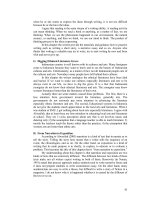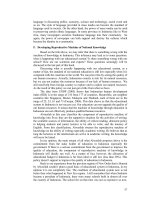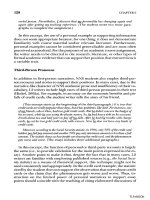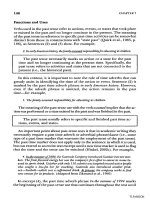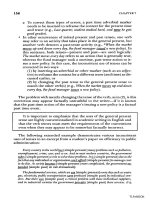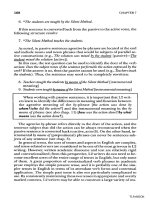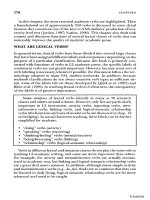Tài liệu Teaching and learning english part 15 doc
Bạn đang xem bản rút gọn của tài liệu. Xem và tải ngay bản đầy đủ của tài liệu tại đây (404.82 KB, 7 trang )
99
D. The Architectonic of Curriculum
An orderly and rational scheme of programming or organizing content
facilities effective curriculum development, we have to analyze the architectonic of
content as they apply to a school situation. Architectonic in selecting the content in
curriculum refers to ordering and arranging content into systematic categories for
the purpose of facilitating learning to achieve maximum effectiveness for students.
Print (1988) states that the term of architectonic related to the structures
needed to present a curriculum and the principles which assist the curriculum
developer to organize the content of a curriculum in such a way so as to achieve
maximum effectiveness for students. For these purposes we have to consider the two
most important principles of the architectonics of content, they are scope of
curriculum content and sequence of curriculum content.
The scope of curriculum content refers to breadth and depth of content to be
studied (Print, 1988). A useful starting point when dealing with the scope of content
in a curriculum is to pose questions about the nature and balance of that content.
According to Print, some questions that we have to ask for instances; how much of
each content area should students study at any one time, is there a body of common
content that all students should know, what should be the role of elective content,
what content should be excluded in the curriculum, etc. Furthermore, there are some
concepts which are helpful in determining the scope of content for a curriculum:
1. Time, refers to the balance that occurs between breadth and depth where the
breadth may be greater time spent on a particular subject theme or may
represent more subject to be taught in a given time period.
2. The notion of a core or common content appear acceptable to educators and
society. The core concept suggests that there is a body of content that all
students should acquire as a result of their schooling experience.
3. The scope of content may also be influenced by the notion that schools should
provide content to meet the special needs of children and adolescent.
4. Integration of content is to be encouraged in order to provide some sense of
reality to the learners.
The sequence of curriculum refers to the order in which content is presented
to learners. To know how content should be arranged for learners, there are several
important related questions to be posed as suggested by Zais (1976) cited by Print
(1988): 1) what criteria should determine the order of content, 2) what should follow
what and why, 3) when should learners acquire certain content. The Sequence may
be influenced by some principles:
1. Simple to complex
In this situation, sequence is seen as a progression from simple, subordinate
components to complex structures, which in turn are subordinate components of
even more complex superordinate structures.
2. Prerequisite learning
This principle is followed in subjects which consist largely of laws and
principles such as physic, grammar, and geometry.
3. Whole to part learning
The rationale for this principle is that understanding the whole makes possible
the understanding of partial or constituent phenomena.
4. Chronology
100
This principle suggests sequencing content according to the chronology of
recorded events.
5. Increasing abstraction
In this situation, content can be sequenced according to the idea that one learners
most effectively what is closer or more meaningful to the learners.
6. Spiral sequence
In connection with the whole curriculum organization, the students should be
exposed to the contents’ basic ideas repeatedly, thus building on basic
understanding until the whole concept or lot of learning has been acquired.
E. The Conclusion
In writer’s perspective, the total educational program refers to the well
programmed of curriculum. Most experts in education believe that one of the ways
to improve the quality of education is through curriculum development. Curriculum
is the core of education, since it provides rigorous planning and program to reach
the objectives of education.
The program of curriculum in this discussion refers to the curriculum
content. Curriculum content is developed started from a situational analysis, goal
formulation and then program building or content building. The content consists of
the facts, concepts, and generalizations, or the knowledge, related to a particular
subject or theme.
The approach toward selecting content varies between one emphasizing a
knowledge based approach, and one emphasizing the process approach. There are
many factors involved in selecting the content of curriculum. The argument for
certain content may prevail if they employ the selection criteria. An orderly and
rational scheme of programming or organizing content, we have to apply the
architectonic of content. Architectonic in selecting the content in curriculum refers
to ordering and arranging content into systematic categories for the purpose of
facilitating learning to achieve maximum effectiveness for students. For these
purposes we have to consider the two most important principles of the architectonics
of content, they are scope of curriculum content and sequence of curriculum content.
References
Miller P, J. (1985). Curriculum Perspective and Practice. New York: Longman Inc.
Posner, G. (1992).
Analyzing the Curriculum .United States: McGraw Hill,Inc.
Print, M. (1988).
Curriculum Development and Design. Australia: Sedney.Docupro.
Saylor, G et al. (1981).
Curriculum Planning for Better Teaching and Learning.
Tokyo: Holt-Saunders Japan
101
The Unique of Children
The Phenomenon of ‘Crying’ and How to Say “No” to Our Children
Muhammad Sukrianto
A. Introduction
The word “Unique” can mean in some ways: 1) “not the same”, means different
from everyone or everything else; 2) “unusual”, means different and not ordinary
often in a way that is interesting or exiting; 3) “special” means different from
normal things, or used for a particular purpose (Cambridge Dictionary).
Based on the meaning of the word “Unique” above, we may get the inference on the
meaning of “the unique of children.” “Children” is unique or different, unusual and
special. Some experts say that children are unique since they have their own world.
The study of child development, that is the study of the physical, cognitive, and
psychosocial changes that children undergo from the moment of conception onward,
have invented the unique of children.
Each of us begins life as a single cell. By the time we are born, we are incredibly
complex organism. We breathe on our own, explore the world with our senses, eat,
and begin to take our place in the family and community that created us. Two years
letter we come to new phase as a child, we can walk, talk, feed ourselves (with help,
to be sure) and play pretend games. Entering this phase, we have our own world that
is “children world” and it is said unique by adults.
One of the unique of children that will be discussed in this short essay is the unique
of “crying”. The inspiration comes from my experience when I saw a child that is
unique in crying. The child was the son of my neighbor. One day he wanted his
mother to buy a toy but his mother didn’t accepted what he wanted. And then the
child cried and he didn’t stop his crying until his mother bought the toy. What
actually the phenomenon of crying? and how to say “no” to our child? All
concerning with these will be shortly discussed on the following.
B. The Phenomena of “Crying”
One of the most difficult problems parents face is when his child is crying. A child
cries have a powerful effect to who hear them. Sometimes parents respond in
different way on their child’s crying. Before, experience parents and childless adults
alike respond to the infant with increases in heart rate and blood pressure, both of
which are physiological sign of anxiety. But later, when the child growth enough,
more often the parents respond rudely and angrily to their child’s crying.
Crying is a complex behavior that involves the coordination of breathing and
movements of the vocal tract. Initially it is coordinated by structures in the brain
stem (Roberts et al., 1995). Infants obviously cannot articulate more their need or
feeling, but they do have one important way of signaling that something is wrong-
they can cry. Crying increase from birth to approximately 6 weeks of age and then
begins to decrease. A child who has been able to articulate his or her need and
feeling still use “crying” as the power to force their parents. As the case I have told
above is one of the phenomena, where the child forces his mother to fulfill his need.
102
Another example is when parents asked their child to do something but the child
does not want to and then cries. With this condition, parents often can not decide
what to do. When their child is crying parents often punish and be angry to their
child. A child who is crying can not concentrate to what he is doing. When parents
ask their child to study, for example, a child can not do it while crying. Actually, a
child cries can be caused by some factors at least because he doesn’t feel comfort
with the condition or cannot have what he needs.
C. How to Say “No” to our children
The power of “crying’ often makes parents just follow to what their child wants.
What parents have to do is to find a good way to make the child follow and not
crying. Actually, there is no mystery as to why children say “No” to parents’ but the
most important thing is parents also can say “No” to their child.
When a child responds to a parent by crying, whining, throwing a temper tantrum,
or just saying “No” it’s common for parents to punish the child. But children who
are highly uncooperative have most likely been punished repeatedly. If punishment
worked, a parent would be using it less often rather than more often with a child
because the result of the punishment would be to reduce or stop the child’s
unfavorable behaviors. Furthermore, when we try to administer punishment, we can
easily get into a power struggle with our child.
Here are some important preconditions proposed by Maagh (2004) to say “No” to
our child when they force us with crying:
First, be aware that some habitual ways of dealing with our child, especially
punishing her, may actually be making the negative interactions worse and
harder to change.
Second, research tells us that the way to make a request of a child can affect
how she responds. It’s easier to avoid power struggles and get compliance
from our child if we give her directions in a clear, direct, and specific fashion.
Third, we have to use as few words as possible, and give her a reasonable
amount of time to comply. By contrast, we may encourage power struggles
with our child if our commands are vague, overly wordy, and include multiple
instructions for the desired behavior (Walker, Ramsey, & Gresham, 2004).
The fourth we must be able to create rapport with our child. Rapport involves
communicating with a child, using the child’s point of view. Say in response?
“No, you’re wrong; I really don’t want to be in style?” Once rapport is
created, it becomes easier to obtain compliance.
D. Conclusion
Crying is a complex behavior as the unique of children. Sometimes parents
respond in different way on their child’s crying. A child who has been able to
articulate his or her need and feeling still use “crying” as the power to force their
parents.
Parents can manage this condition with positive and effective strategies. Don’t
punish them, but the most important thing is parents also can say “No” to their child.
Parents may have to step outside the comfort zone and get creative in responding to
the child’s misbehavior.
103
References
Maag, JW. 2004. Strategies of Managing Resistance.
/> (February 20
th
2007
Cole M., Cole S. 2001.The Development of Children.USA Sandiago: University of Callifornia.
Walker, H. M., Ramsey, E., et al. 2004.Antisocial behavior in school: Evidence-based
practices (2
nd
ed.). Belmont, CA: Wadsworth/Thomson,

